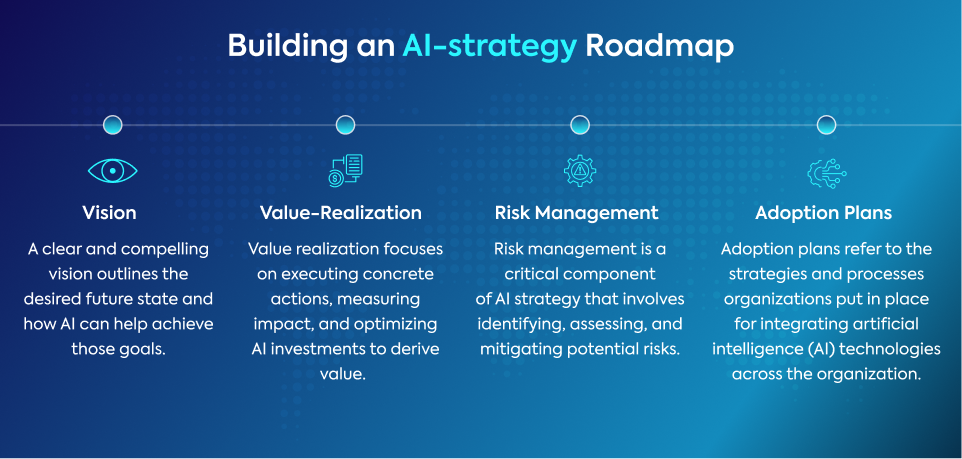AI Roadmap Mirage: Why Most Strategies Look Great In the Beginning
How to use ChatGPT/Claude or Gemini to Build Your AI Strategy
Hey AI Productivity Explorer,
Last week, I was in Tokyo working with one of my clients, a mid-market client that had launched an ambitious 3-year AI roadmap last July. Their vision was clear, the executive buy-in was strong, and every department was aligned. On paper, it was one of the best AI strategies I’d seen in a while. But now, almost 10 months later, the roadmap felt more like wishful thinking than a guiding compass.
During our workshop, their head of operations pulled me aside. “Sameer, we’ve automated parts of our analytics pipeline, brought in a vendor for document summarization, and even piloted a custom GPT for customer service,” she said. “But we are not seeing a clear ROI yet, and we are getting pressure from our senior leadership to demonstrate value, given it has been a year.”
Her frustration reminded me of a lesson from another Japanese innovation story, one that shaped global business systems long before AI was even a concept.
In post-war Japan, Toyota wasn’t trying to become the biggest carmaker. They were simply trying to survive. With scarce resources and minimal inventory, they couldn’t afford the inefficiencies of Western-style mass production. So instead of copying Detroit’s model, they built their own: The Toyota Production System.
It was revolutionary not because it used new machinery, but because it relentlessly focused on execution. Waste was eliminated. Processes were mapped. Feedback loops were constant. Every movement on the factory floor had a reason and could be improved.
That system didn’t stay in Japan. It became the foundation of lean manufacturing, Six Sigma, agile methodology, and yes, even modern AI operations.
And yet, despite all we’ve learned since, companies today still repeat the same mistake: mistaking a beautifully drawn strategy for a working system.
So here’s the uncomfortable question we all need to ask right now, especially mid-way through Q2:
Is your AI roadmap truly guiding your business forward, or is it just another polished document collecting digital dust?
Here’s what we will cover below:
Why Good AI Strategies Fail
Early Warning Signs Your Roadmap Is Slipping
How to Build an AI Strategy That Actually Works
Exact advanced AI prompt to help you build your strategic roadmap.
Why Good AI Strategies Fail
It’s tempting to believe that having a brilliant strategy guarantees successful outcomes, but as my Tokyo client discovered, even the best-laid plans can stall during execution. After years of helping companies untangle ambitious AI initiatives, I’ve observed that the most common failure points aren’t technical, but they’re strategic blind spots that emerge precisely when theory meets practice.
First, companies often set overly ambitious goals without clearly mapping the intermediate steps needed to achieve them.
AI projects must be iterative and incremental. Yet, leadership frequently sets lofty targets like “fully automating customer support” or “achieving complete predictive analytics capability” without detailing how exactly they’ll get there. When a client in Tokyo admitted they’d aimed to automate 70% of their customer interactions by mid-2025, I had to ask: “Did you define precisely which interactions from the list you have prioritized? Did you validate your assumptions on customer acceptance or reluctance to use AI?”
I immediately sensed quiet discomfort from the team. In Japan, customer service isn’t just a business function, it’s a point of national pride. Concepts like omotenashi (wholehearted hospitality) shape how people interact with customers, where attentiveness, respect, and human touch are deeply valued.
The idea of replacing that with a bot, even a sophisticated one, wasn’t just a technical challenge; it was a cultural shift that made many feel uneasy, even if they didn’t say it outright.
Another critical misstep is misalignment between strategy and operations.
Beautifully designed roadmaps often ignore the gritty reality faced by the operational teams tasked with implementing them. Too many times, I’ve walked into meetings where frontline staff and data teams share a common frustration: “We have no idea how this new AI initiative integrates into our current workflow.” The roadmap looked elegant on paper, but failed because nobody thought to bridge that crucial gap between strategic vision and daily execution.
Source: Microsoft
Finally, there’s the tendency to overlook ground realities like data readiness, infrastructure maturity, and internal skills gaps. I recently met with another founder proudly showcasing an AI-driven personalization system. It looked fantastic in theory until we realized their data infrastructure couldn’t handle real-time data flows. They’d designed a Ferrari but were still driving on a dirt road.
These common pitfalls highlight an inconvenient truth: a good strategy is meaningless without precise execution.
If your AI roadmap doesn’t factor in realistic conditions, limitations, and operational alignment from day one, it’s already set to fail no matter how compelling it looks on paper.
To make progress, you have to stop treating AI as a purely strategic exercise and start managing it like Toyota managed its assembly lines: relentlessly pragmatic, execution-focused, and obsessively tuned to real-world conditions.
Identifying Early Warning Signs of an Unrealistic AI Roadmap
Before an AI roadmap completely derails, there are always early signs, often subtle, but rarely invisible. The challenge is recognizing them while there’s still time to course correct.
When my Tokyo client first mentioned their ambitious target of automating 70% of customer interactions, the quiet hesitation among the team was one such subtle indicator. Another was the frequent revisions made to their timeline dates, sliding quietly from March to April, then into Q3 with no explicit discussion or accountability. If your organization finds itself continually adjusting timelines without reassessing core objectives, that’s a clear sign your roadmap might be drifting into wishful thinking territory.
Another common warning sign is a lack of clarity among the operational teams about their role in executing the AI strategy.
I often ask teams directly: “Do you clearly understand your responsibilities within this roadmap?” If the answer is ambiguous, or worse, hesitant silence, there’s likely a dangerous disconnect between your strategic vision and operational reality. This confusion not only stalls progress but can demoralize teams who feel their practical concerns are ignored.
High dependency on external consultants is another subtle yet significant indicator.
Consultants are valuable, but excessive reliance on them without internal capability-building can mean your roadmap isn’t sustainable. In Tokyo, I noticed the client’s operations leader frequently deferring to outside experts on critical decisions such as complex data design or understanding of intricate business process complexity, unintentionally weakening internal buy-in and delaying crucial internal learning.
Consider conducting a quick “mid-year roadmap health check” within your organization. Gather your team and ask these simple but revealing questions:
Are we constantly shifting AI milestones without openly addressing the root cause?
Do all team members clearly understand their roles in our AI initiatives?
Are we relying too heavily on external expertise without adequately preparing our internal teams?
If your answers raise red flags, it’s time to recalibrate, not at year’s end, but right now, while you still have the flexibility to course correct.
In AI strategy, as in all strategy, the best leaders are the ones those who recognize early when things are off track and dare to adjust decisively.
How to Build an AI Strategy Roadmap That Actually Works
To avoid the pitfalls discussed, your AI roadmap must follow a structured, practical approach that ensures alignment, measurable value, risk awareness, and clear adoption plans.
Start with a compelling Vision.
Clearly articulate your desired future state define what success looks like with AI integrated into your organization. Your vision isn’t about the technology itself; it’s about how AI supports your broader business objectives. For my Tokyo client, this meant shifting the vision from vague automation targets to concrete outcomes like enhancing customer loyalty through personalized, empathetic interactions aligned with Japanese cultural norms.
Next, emphasize Value-Realization.
Every AI initiative must connect to measurable business outcomes. Clearly identify and prioritize initiatives based on impact, feasibility, and time-to-value. Regularly measure progress and optimize as you go. For example, rather than blanket automation of customer interactions, focus on automating interactions that demonstrably enhance efficiency without compromising the valued human touch integral to Japan’s service culture.
Then, proactively manage Risk.
Identify potential risks upfront, including technological limitations, regulatory concerns, data privacy issues, and cultural resistance. Develop clear mitigation strategies. With my Japanese client, we directly addressed the cultural anxiety around automation by providing clear reassurances, conducting internal workshops on human-AI collaboration, and maintaining human oversight in critical customer interactions.
Finally, create detailed Adoption Plans.
A successful AI strategy is only as good as its execution plan. Define clear roles, responsibilities, timelines, and dependencies across teams. Regularly communicate progress, refine based on feedback, and ensure continuous skill-building. Practical, incremental adoption, rooted in day-to-day workflows and clear communication, turned the Tokyo team’s skepticism into active support.
Ultimately, a robust AI roadmap is pragmatic and human-centric, clearly connecting ambitious AI initiatives to everyday operational realities. Only then does your strategy become a living, guiding force rather than just another polished, unused document.
Let’s put this into action by using your favourite AI tool to help you create a strategic ROI focussed AI roadmap.
Here is the detailed advanced prompt you can copy and paste into your favorite AI tool.
Keep reading with a 7-day free trial
Subscribe to Solve with AI to keep reading this post and get 7 days of free access to the full post archives.






